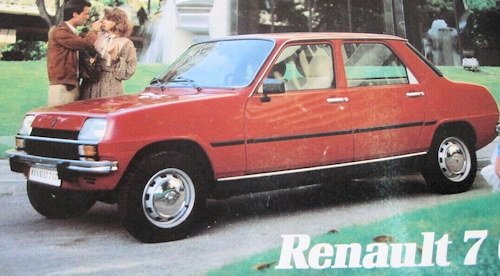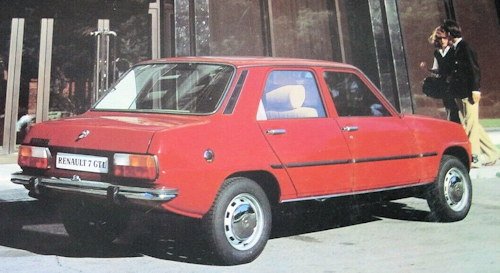Renault 7
 |
|
|
Make |
FASA-Renault |
|
Production |
1974 to 1984 |
|
Class |
motor car |
|
Fuel type |
gasoline |
|
Engines |
Cléon-Fonte |
|
Transmission |
4 speeds |
|
Unloaded weight |
815 kg |
|
Body |
notchback |
|
Length |
3,890 mm |
|
Width |
1,525 mm |
|
Height |
1400 mm |
The Fasa-Renault 7 is a model produced for the Spanish market built from the mid 1970s to the mid 1980s .
History
Its body, which is based on the platform of the Renault 5 , is has a trunk, 4 doors and metal bumpers. Produced from 1974 to 1982, it was first marketed under the name Siete (seven in Spanish) before being renamed 7 in 1979 during a slight restyling.with a total of240,000 copies built.
The design was based on a three-body model (engine, passenger compartment and trunk), and had been released in various prototypes in the early 1970s, but never produced a series model in France . On the other hand, its commercialization in Spain went ahead, since this type of vehicle covered the space and economy needs of middle-class families, which had been orphaned with the appearance of the new European B-segment vehicles.
With the move to front-wheel drive, small vehicles in Europe had one after another abandoned sedan bodies in favor of new hatchback bodies, with three-volume bodies being offered in higher segment vehicles ( Renault 12 , Peugeot 504 ). or designed during the previous decade ( Renault 8 , SEAT 124 ).
To denote its Spanish character, the initial model was called "Renault Siete", written in letters. It was equipped with a 1,037-cubic-centimeter, 50-hp engine, specifically designed not to exceed the 1,040-cubic-centimeter barrier, which in Spain then involved the payment of a tax. This car stood out for its good visibility, its balanced suspensions and its ample cargo space, with the brakes being its biggest flaw, somewhat fair in relation to the weight of the vehicle. It reached a top speed of 132 km / h, and the combined consumption was about 6 liters / 100 km. It was marketed in two versions, the "normal", without specific nomenclature, and the TL, with some additional aesthetic and comfort details. In 1977 the normal version disappeared, leaving only the TL.
In 1979 a restyling of the model was carried out by incorporating some aesthetic elements, such as a four-spoke steering wheel, a new dashboard and brake booster, to try to give the image of the vehicle a look more in line with the tastes of the time. At the rear, larger lights housed the reversing lights. In addition, the nomenclature was changed from "Renault Seven TL" to "Renault 7 TL". In 1981, the GTL version arrived, with head restraints on the front seats and the Cléon-Fonte 1108 cc engine in its high compression version and 45 hp (DIN) at 4,400 rpm, which also replaced the 1037 cc engine in the Renault 5. GTL.
These changes kept the model on the market until 1984. At the time of its production closure, 159,533 units had been manufactured.
The presence in the Spanish range of a sedan based on the Renault utility model did not continue when changing from the Renault 5 to the Renault Supercinco . However, it has been carried out in other countries with current models such as the Renault Clio saloon, which is manufactured in Morocco and South America , and is sold in some European countries such as Renault Clio Symbol or Renault Thalia.
Equipped with a 1,037 cm 3 " Cléon-Fonte " engine developing 50 hp for a maximum speed of 132 km / h and a consumption of 6 liters per 100 km , it was offered only in TL finish. In 1979 , a better finished GTL finish appeared, it benefited from a " Cléon-Fonte engine " of 1 108 cm 3 of 47 hp .

Technical
-
Renault 7 technical details and specifications (1974-1984)
Renault 7
Period
1974-1983
Type of motor
L4 8v, carburetion
Motor identification
850
Bore x stroke
67.7mm x 72.0mm
Displacement
1037 cm³
Compression ratio
9.5: 1
Maximum power: CV (kW) @ rpm
50 hp (37 kW) @ 5500
Maximum torque: Nm @ rpm
73 Nm @ 3000
